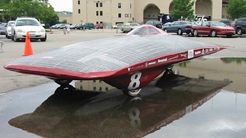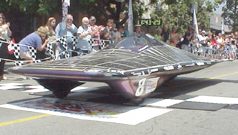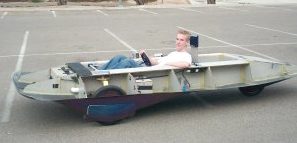|
The
Arizona Solar Racing Team was established in the Summer of 1997 at the
University of Arizona, with the goals of enhancing engineering education
and renewable energy at the University. The team’s first project was
building a competitive solar car for Sunrayce 99, the fifth iteration of
a biennial solar vehicle competition open to Colleges and Universities
across North America. After recruiting several students as team members
and developing funding over the next several months, the Arizona Solar
Racing Team began designing and constructing its first solar powered
vehicle early in 1998.
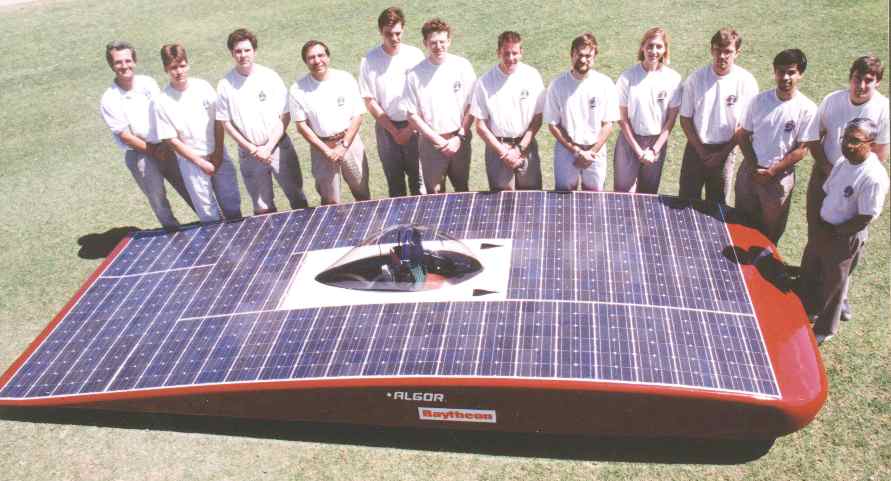
Arizona
University Solar Car Team - Daedalus
The University is getting the project rolling once again for 2006. There
are hundreds of things to do to get Drifter ready for the 2006 race.
Check out their "How to Help" section link below if you'd like
to be a part of this exciting project. All
majors are always welcome. If you want to work on a high-tech racecar,
this is the place to be, regardless of your level of training.
The
team are especially seeking members for our business team, which is
responsible for managing finances, organizing events, and keeping the
engineers on track. If you're a business or engineering management major
looking for experience on a real-world project, they'd love to meet you!
1999
DAEDALUS PROJECT LESSONS
To
avoid the problems of most rookie teams, the Arizona Solar Racing Team
(then called the Daedalus Project) began by extensively researching
previous successful solar vehicle designs, especially low-effort and
low-cost engineering solutions that could be successfully implemented by
a small team. The concept for Daedalus was to build as robust and
reliable a solarcar as possible.
As
a result of this philosophy, Daedalus, as completed in late March of
1999, was approximately 100 pounds heavier than the Sunrayce-average but
proved surprisingly robust and reliable in initial testing. This success
carried over to the Sunrayce 99 Qualifiers, an event in which the total
number of miles that could be driven in one day determined the starting
order for Sunrayce. Held at GM’s Milford Proving Grounds in Milford,
MI, Daedalus managed to run the 6th greatest number of miles with
impeccable reliability, beating out many more established teams in the
process. Although not the 6th most efficient car in the field, this was
a testament to the design strategy of Daedalus, as it was one of the
only cars to run flawlessly for all 8 hours. This placed the Arizona
Solar Racing Team as the best-qualified rookie team in the history of
Sunrayce.
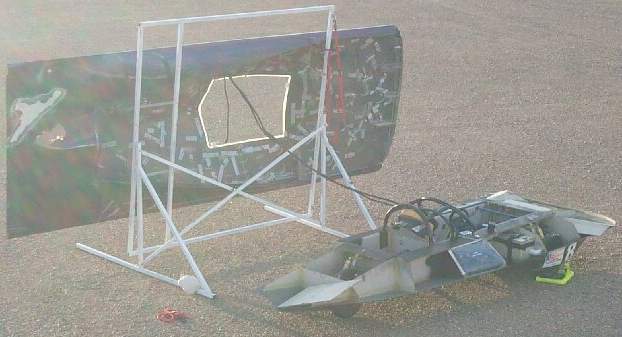
Arizona
University Solar Car - Monsoon
Sunrayce
99 quickly proved to be a race where strategy, not overall speed,
determined finishing position. With cloudy conditions on 8 of the 9 race
days, and rain for most of those days, no team was able to gather enough
energy with their solar array to drive all 1423 miles of the race. Those
miles not completed were driven with the solarcar in a trailer, with a
system of penalties attached to the number of miles trailered each day.
An
integral part of race strategy is an electrical telemetry system on the
car which provides accurate measurements of battery state-of-charge,
allowing a team to make important race decisions, such as when and where
to trailer. Unfortunately, the telemetry system for Daedalus was not
ready by the time of the race, and the team was limited to making
strategy decisions based on incomplete information.
The
lessons of Sunrayce 99 (Rainrayce) and Daedalus were incorporated into
the design of the team’s second car, Monsoon, named partly in homage
to the experience of Sunrayce 99. With the additional manpower and
greater financial investment afforded by a more experienced team,
Monsoon was able to incorporate better-optimized engineering solutions
that allowed the team to be more competitive against the best that other
University teams have to offer. However, no one will forget the
experience of Daedalus and the team's first solar racing opportunity in
Sunrayce.
Car
Name: Turbulence
Car Number: 8
Project Time: 24 months
Team Size: 15 members
Testing Miles: 50 miles
Project Cost: $250,000
Length:
4.99 m (196.5 in)
Width: 1.79 m (70.5 in)
Height: 0.9 m (35.4 in)
Wheelbase: 2.29 m (90.0 in)
Front Track: 1.27 m (50.0 in)
Rear Track: Single rear wheel
Ground Clearance: 0.1 m (9.3 in) minimum at body
Weight: 233.6 kg (515 lb) without driver
Weight Distribution: 63 % front / 37 % rear
Vehicle
shape: Integrated Canopy Design with Splined Array Shape and
Rounded Wheel Fairings
Frontal Area: 1.01 m^2
Cd: estimated 0.125
Structural
Construction/Materials: Pre-fabricated Carbon Fiber/Aluminum
Honeycomb composite sandwich boards, adhesively bonded with fiberglass
and epoxy reinforcement. Welded steel tube roll cage structure
adhesively bonded to frame.
Body Construction/Materials: Pre-preg Carbon Fiber/Polyurethane
foam composite sandwich. Moldless construction using body plug to form
inner foam sandwich.
Tires: Michelin 65/80, 85 psi
Wheels: Custom Machined Aluminum by Raytheon
Front Brakes: MCP hydraulic calipers on steel cross-drilled
disc
Actuation Method: MCP hydraulic master cylinder and foot pedal
Rear Brake: Magura hydraulic rim brake on motor wheel
Actuation Method: Magura hydraulic hand lever actuated by front
brake pedal
Front Suspension: Machined aluminum A-Arms and suspension
upright, Yarnell air spring/shock.
Rear Suspension: Semi trailing A-arm design, geometry identical
to front suspension, Yarnell air spring/shock.
Steering: Steering wheel, Yarnell rack and pinion, Ackermann
steering geometry.
Motor/Controller:
New Generation Motors EV-C200-092 Controller, SC-M150 Brushless DC
Motor
Power: Maximum power output of 6.4 kW (8.6 hp)
Efficiency: Maximum system efficiency of 94%
Controls: Separate pedals/potentiometers for throttle and
regenerative braking
Battery
Type: Saft HE-41 Li-ion
# of Batteries: 27
Mass: 30 kg (66.1 lb)
Pack voltage: 94.5 volts nominal
W-hr capacity: 3.93 kW-hr
Solar
Cell type: 550 RWE Schott monocrystalline silicon and 660 Emcore
triple-junction GaAs
Active Solar Array area: 8 m^2
Construction/encapsulation technique:
736.5 solar cells in 5 series strings
Tefcel / Tedlar / EVA laminate modules adhesively bonded to body
Laminate construction by SunWise Solar
Normalized array output: 1200 watts
Measured array efficiency: 16% silicon, 23% GaAs
Maximum measured output: 1030 watts
Peak Power trackers: 5 Biel School MPPTnG A0401, Boost Type
Average Power Tracker Efficiency: 99%
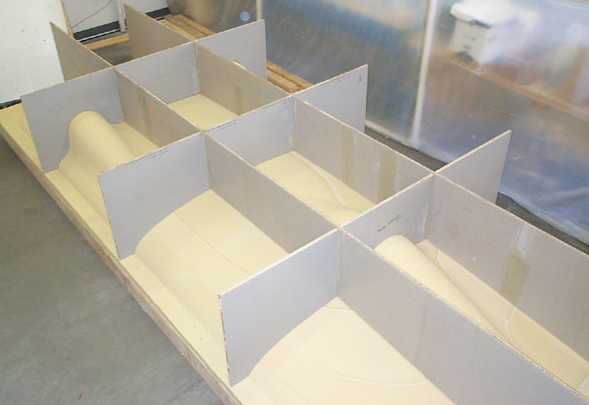
Arizona
University Solar Car Team - Composite moulds
Administrative
Team
Mechanical
Team
Team
Leader
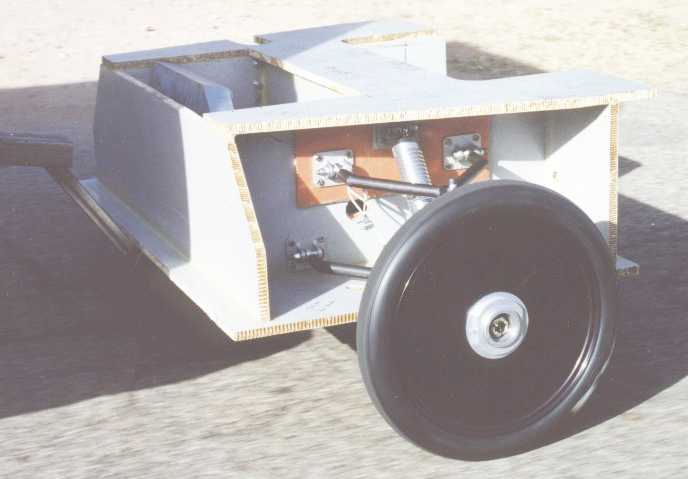
Arizona
University Solar Car Team - Test rig
PROJECT
DAEDALUS - SPECIFICATIONS
Car
Name: Daedalus
Car Number: 8
Project Time: 22 months
Team Size: 12 members
Testing Miles: 630 miles
Project Cost: $128,000
Length:
5.23 m (205.9 in)
Width: 1.97 m (77.6 in)
Height: 0.92 m (36.2 in)
Wheelbase: 2.16 m (85.0 in)
Front Track: 1.49 m (58.5 in)
Rear Track: 0.21 m (8.4 in)
Min. Ground Clearance: 0.18 m (7 in) at tail
Weight: 363 kg (800 lb) without driver
Weight Distribution: 57 % front / 43 % rear
Vehicle
shape: Flat bottom wing-section with bubble canopy.
Frontal Area: 1.03 m^2
Cd: estimated 0.19
Structural
Construction/Materials: Pre-fabricated Fiberglass/Honeycomb
composite sandwich boards, adhesively bonded with fiberglass and epoxy
reinforcement. Welded steel tube roll cage structure with integrated
rear shock mount adhesively bonded to frame.
Body Construction/Materials: Moldless construction with
Fiberglass/Honeycomb flat composite board structure, and wet-layup
fiberglass weave over shaped styrofoam for outer aerodynamic surfaces.
Tires: Bridgestone Ecopia EP80, 115 psi
Wheels: NGM Machined Aluminum
Wheel Bearings: Champion 6205 Deep Groove, Ceramic Ball
Rolling Resistance: Crr: 0.003 to 0.008 over speed range
Primary Brakes: MCP hydraulic calipers on steel cross-drilled
disc
Actuation Method: MCP hydraulic master cylinder and foot pedal
Secondary Brakes: Shimano bicycle brake on left rear wheel
Actuation Method: Shimano bicycle handbrake
Front Suspension: Steel A-Arms with aluminum upright, Yarnell air
spring/shock.
Rear Suspension: Single centrally-mounted aluminum trailing arm,
Yarnell air spring/shock.
Steering: Steering wheel, Yarnell rack and pinion, Ackermann
steering geometry.
Motor/Controller:
New Generation Motors EV-C200-092 Controller, SC-M150-08 Brushless DC
Motor
Power: Maximum power output of 6.05 kW (8.1 hp)
Efficiency: Maximum system efficiency of 94%
Controls: Integrated throttle / regenerative braking system with
single accelerator pedal / potentiometer
Battery
Type: Delphi Lead Acid AGM / SLI, 12 volts
# of Batteries: 9
Mass: 146 kg (324 lb)
Pack voltage: 108 volts nominal
W-hr capacity: 4950 W-hr at C/3 discharge rate
Solar
Cell type: Siemens Type II, 14.1 % nominal efficiency
Active Solar Array area: 7.70 m^2
Construction/encapsulation technique:
726 solar cells in 4 series strings
Tedlar / EVA laminate modules adhesively bonded to body
Laminate construction by SunCat Solar
Normalized array output: 1120 watts at 1000 watts/m^2, AM1.5, 25
deg. C
Measured array efficiency: 14.5 %
Maximum measured output: 1230 watts
Peak Power trackers: 4 Solectria MPT-150N, Boost Type
Average Power Tracker Efficiency: 96%
LINKS:
Home
| Project
Updates | Sponsorship
Info | Our
Sponsors | Adopt-A-Cell
How
to Join | How
to Help | Pictures
| Meeting
Schedule | Members
| Technical
CONTACTS:
|
Email
Address:
|
solarcar@email.arizona.edu
|
|
Telephone:
|
(520)
626-5373
|
|
Fax:
|
(520)
621-8191
|
|
US
Mail:
|
Arizona
Solar Racing Team
University of Arizona
1130 N. Mountain Ave.
Tucson, AZ 85721
|
ON
CAMPUS:
Aerospace & Mechanical
Engineering Building, Room N213. A map to the AME Building is located
to the right. For directions to the AME Building from outside the
University of Arizona, please check your favorite online map maker.
|
ORGANISATION
A-Z
|
CAR'S
NAME
|
TEAM
NAME
|
|
Aristotle
Uni of Thessaloniki, Helios
|
Helios
|
Faculty
of Engineering
|
|
Arizona
Solar Racing Team - USA |
|
Arizona
Solar Racing Team |
|
Auburn
University |
Sol
of Auburn |
Sol
of Auburn |
|
Aurora
Team, Australia |
Aurora |
Aurora
Vehicle Association |
|
Bochum
Solar Car Team |
|
Das
SolarCar der Fachhochschule |
|
California
Poly S University |
SLO
Burn Sidewinder |
San
Luis Obispo |
|
Clarkson
Uni Solar Car Team, USA |
|
The
Solar Knights |
|
Delft
University - Holland |
NUNA
I & II
2003
|
|
|
Dell
Winston School |
The
Hunter |
Solar
Car Challenge |
|
Desert
Rose, Northern Territory Uni |
FUJI
DESERT ROSE |
|
|
Drexel
SunDragon Home Page |
|
|
|
École
de technologie supérieure Quebec |
Eclipse
V (5) |
Éclipse
Vehicular Solaire |
|
École
Polytechnique de Montréal
|
Esteban
|
|
|
Eko-Auto
Poland |
Eko-Auto |
|
|
Electron
Analytic Corporation
|
Dark
Horse
|
EAC
Skunkworks
|
|
George
Washington University |
|
George
Washington Uni Solar Car |
|
Georgia
Institute of Technology |
Solar
Jackets |
Solar
Jackets |
|
Heliodet,
Germany |
Heliodet |
Heliodet,
Solar Car Team |
|
Helios
- Lille, France |
Hélios IV |
Hautes
Etudes d'Ingénieur |
|
Honda
Car Company |
Honda |
|
|
Illinois
State University
|
Surya,
Ratha, Mercury
|
Illinois
State University
Team
|
|
Iowa
State University
|
Fusion
|
Team
PrISUm
|
|
Jonasun
Japan |
Orbit |
Solar
Car Paviion |
|
Kansas
State University
|
Paragon
|
Solar
Car Racing Team
|
|
Los
Altos Academy of Engineering |
|
Los
Altos Solar Car Team |
|
Massachusetts
Institute of Technology
|
Tesseract
|
MIT
|
|
McGill
University
Monteal, Canada
|
iSun
|
Team
iSun
|
|
McMaster
University
|
Phoenix
|
McMaster
Uni
Solar Car Project
|
|
Messiah
College
Grantham, Penns |
Genesis
II |
Genesis
II Solar Racing Team |
|
Michigan
State University
|
|
Solar
Racing Team
|
|
Michigan
Technological University |
|
Solar
Car Team |
|
Minnesota
S Uni-Mankato/Winona S Uni |
|
Minnesota
Solar
Car Team |
|
North
Dakota State University
|
The
Double Deuce
|
Sunsetters
- Solar Race Team
|
|
Northwestern
University
|
N'Uvation
|
Northwestern
University
|
|
Nuon
Solar Team, Netherlands |
Nuon
3 |
Het
Nuon Solar Team |
|
Osaka
Sangyo University, Japan |
OSU
model S |
Solar
Car Team |
|
Prairie
View A&M University
|
Solaris
|
Sun
Panthers
|
|
Principia
College
|
RA
6
|
Principia
College
Solar Car Team
|
|
Purdue
University
|
SPOT
2
|
Purdue
University
Solar Racing
|
|
Queen's
University Canada
|
Radiance
Gemini
|
Queen's
Solar Vehicle Team
|
|
Red
River College
|
Red
River Raycer
|
Red
River College Solar
Car Team
|
|
Rice
University |
|
Rice
University |
|
Rose-Hulman
Institute of Technology
|
|
Rose-Hulman
Solar Car Team |
|
Southern
Illinois Uni Edwardsville
|
Cougar
Cruiser
|
Southern
Illinois University
|
|
South
Bank University, UK |
Mad
Dog |
South
Bank Mad Dog Team |
|
South
Dakota School Mines & Tech |
Solar
Motion |
South
Dakota Solar Motion Team |
|
Southern
Taiwan University Tech |
|
Southern
Taiwan Solar Team |
|
Stanford
University
|
Solstice
|
Stanford
Solar Car Project
|
|
Tamagawa
University - Japan |
|
Tamagawa
Solar Challenge Project |
|
Team
Futura, Italy |
FUTURA
2 |
Team
Futura |
|
Team
SunLake - Japan |
Phaethon
model |
Team
SunLake TOYOBO |
|
Texas
A&M University
|
Columbia
Sunraycer
|
Texas
A&M
Motorsports Team
|
|
The
Power of One
- Toronto |
Xof1 |
The
Xof1 solar car team |
|
Tufts
University
|
ANNE
E. B. II
|
Nerd
Girls
|
|
University
of Alberta |
|
University
of Alberta Team |
|
University
of Arizona
|
Drifter
|
Solar
Racing Team
|
|
University
of Calgary
|
|
UC
Calgary
Solar Car Team
|
|
University
of California-Berkeley |
CalSol |
California
Calsol Team |
|
University
of Kansas |
Solution,
CATalyst |
KSU
Solar Car Racing Team |
|
University
of Kentucky
|
Gato
del Sol II
|
Solar
Car Team
|
|
University
of Massachusetts |
Spirit
of Mass 413 |
Lowell
Solar Racing Team |
|
University
of Michigan
|
Momentum
|
University
of Michigan
|
|
University
of Minnesota
|
Borealis
III
|
U
of M Solar Vehicle Project
|
|
University
of Missouri
- Columbia
|
Suntiger
VI
|
The
Mizzou Solar Car Project
|
|
University
of Missouri -
Rolla
|
Solar
Miner V
|
Solar
Minor Car Team
|
|
University
of North Dakota |
Subzero
3 |
Team
SubZero |
|
University
of Ontario Institute of Tech |
|
UOI
Solar Vehicle Team |
|
Uni
of New South Wales SCR Team |
UNSW
Sunswift III |
New
South Wales SCR Team |
|
University
of Patras, Hermes |
|
Solar
Car Team |
|
University
of Pennsylvania
|
Keystone
|
Penn
Solar Racing
|
|
University
of Queensland |
Sunshark |
Queensland
Solar Team |
|
University
of South Australia |
Ned
KELLY |
SA
Solar Car Consortium |
|
University
of Texas at Austin
|
Solar
Steer
|
Solar
Vehicles Team
|
|
University
of Texas at El Paso
|
|
Solraycers
|
|
University
of Toronto
|
Blue
Sky
|
Blue
Sky Solar Racing
|
|
University
of Toulouse |
Heliotrope |
Heliotrope
Solar Car Team |
|
University
of Utah
|
|
Vehicle
Design Team
Utah
|
|
University
of Virginia
|
|
UVa
Solar Car Team
|
|
University
of Waterloo
|
Midnight
Sun VIII
|
Midnight
Sun Solar Race Team
|
|
University
of Western Ontario
|
Sunstang
|
Sunstang
USP
Solar Car Team
|
|
USP
Solar Car Team |
|
USP
Solar Car Team |
|
Western
Michigan University
|
Sunseeker
05
|
W
Michigan Solar Car Team
|
|
Yale
University
|
The
John Lee
|
Team
Lux
|
SOLAR CAR EVENTS
American
Solar Challenge American
Tour de Sol
American
World Solar Challenge - Formula Sun
Australian
World Solar Challenge
Canadian
Solar Discovery Challenge
Dream
Cup Solar Car Race Suzuka 2003 - Japan
Japanese
World Solar Car Rallye
North
American Solar Challenge
Phaethon
2004
Solar
Express - Solar Bike Race
Sunrayce
SunRace
2003 - Australia
World
Solar Car Rally - Japan
World Solar Rallye
- Japan
SOLAR
CAR PART FINDER
A
taste for adventure
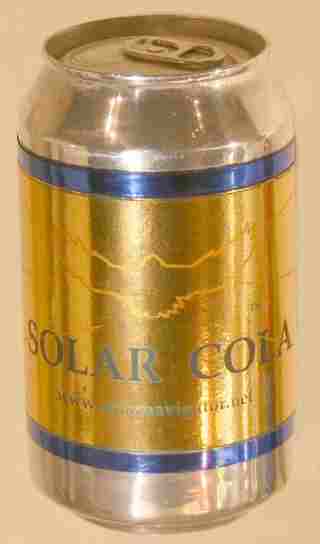
Solar
Cola - a healthier alternative.
|



